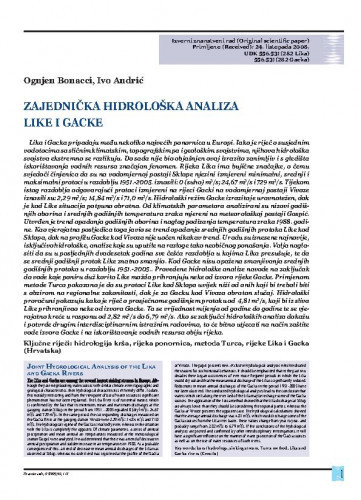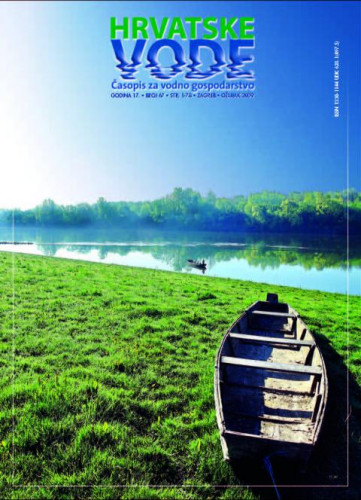Lika i Gacka pripadaju među nekoliko najvećih ponornica u Europi. Iako se radi o susjednim vodotocima sa sličnim klimatskim, topografskim pa i geološkim svojstvima, njihova hidrološka svojstva ekstremno se razlikuju. Do sada nije bio objašnjen ovaj izrazito zanimljiv i s gledišta iskorištavanja vodnih resursa značajan fenomen. Rijeka Lika ima bujične značajke, o čemu svjedoči činjenica da su na vodomjernoj postaji Sklope njezini izmjereni minimalni, srednji i maksimalni protoci u razdoblju 1951.-2005. iznosili: 0 (suho) m3/s; 24,67 m3/s i 729 m3/s. Tijekom istog razdoblja odgovarajući protoci izmjereni na rijeci Gacki na vodomjernoj postaji Vivoze iznosili su: 2,29 m3/s; 14,84 m3/s i 71,0 m3/s. Hidrološki režim Gacke izrazito je uravnotežen, dok je kod Like situacija potpuno obratna. Od klimatskih parametara analizirani su nizovi godišnjih oborina i srednjih godišnjih temperatura zraka mjereni na meteorološkoj postaji Gospić. Utvrđen je trenda opadanja godišnjih oborina i naglog podizanja temperatura zraka 1988. godine. Kao vjerojatna posljedica toga javio se trend opadanja srednjih godišnjih protoka Like kod Sklopa, dok na profilu Gacke kod Vivoza nije uočen nikakav trend. U radu su iznesena najnovije, isključivo hidrološke, analize koje su uputile na razloge tako neobičnog ponašanja. Valja naglasiti da su u posljednjih dvadesetak godina sve češća razdoblja u kojima Lika presušuje, te da se srednji godišnji protok Like znatno smanjio. Kod Gacke nisu opažena smanjivanje srednjih godišnjih protoka u razdoblju 1951.-2005. Provedene hidrološke analize navode na zaključak da vode koje poniru duž korita Like možda prihranjuju neke od izvora rijeke Gacke. Primjenom metode Turca prikazano je da su protoci Like kod Sklopa uvijek niži od onih koji bi trebali biti s obzirom na regionalne zakonitosti, dok je za Gacku kod Vivoza obratan slučaj. Hidrološki proračuni pokazuju kako je riječ o prosječnome godišnjem protoku od 4,81 m3/s, koji bi iz sliva Like prihranjivao neke od izvora Gacke. Ta se vrijednost mijenja od godine do godine te se vjerojatno kreće u rasponu od 2,82 m3/s do 6,79 m3/s. Ako se zaključci hidroloških analiza dokažu i potvrde drugim interdisciplinarnim istražnim radovima, to će bitno utjecati na način zaštite vode izvora Gacke i na iskorištavanje vodnih resursa obiju rijeka..; The Lika and Gacka are among the several largest sinking streams in Europe. Although they are neighbouring watercourses with similar climate, even topographic and geological characteristics, their hydrological characteristics extremely differ. To date, this notably interesting and from the viewpoint of use of water resources significant phenomenon has not been explained. The Lika River is of torrential nature, which is confirmed by the fact that its minimum, mean and maximum discharges at the gauging station Sklope in the period from 1951 - 2005 equaled 0 (dry) m3/s, 24.67 m3/s and 729 m3/s. In the same period, the corresponding discharges measured on the Gacka River at the gauging station Vivoze were 2.29 m3/s; 14.84 m3/s and 71.0 m3/s. The hydrological regime of the Gacka is markedly even, whereas in the situation with the Lika is completely the opposite. Of climate parameters, a series of annual precipitation and mean annual air temperatures measured at the meteorological station Gospić were analyzed. It was determined that there was a trend of decrease in annual precipitation and sudden increase in air temperatures in 1988. As a probable consequence of this, a trend of decrease in mean annual discharges of the Lika was observed at Sklope, whereas no such trend was registered at the profile of the Gacka at Vivoze. The paper presents new, exclusive hydrological analyses which indicated the reasons for such unusual behaviour. It should be emphasized that in the past two decades there began occurrences of ever more frequent periods in which the Lika would dry out and that the mean annual discharge of the Lika is significantly reduced. Reductions in mean annual discharges of the Gacka in the period 1951-2005 have not been observed. The conducted hydrological analyses lead to the conclusion that waters which sink along the river bed of the Lika maybe recharge some of the Gacka sources. The application of the Turca method showed that the Lika discharges at Sklope are always lower than they should be considering the regional patters, whereas the Gacka at Vivoze presents the opposite case. The hydrological calculations showed that the average annual discharge was 4.81 m3/s, which would recharge some of the Gacka sources from the Lika river basin. These values change from year to year, and probably range from 2.82 m3/s to 6.79 m3/s. If the conclusions of the hydrological analyses are proved and confirmed by other interdisciplinary investigations, it will have a significant influence on the manner of water protection of the Gacka sources as well as on the use of water resources of both rivers.
Sažetak
Dio sveska

